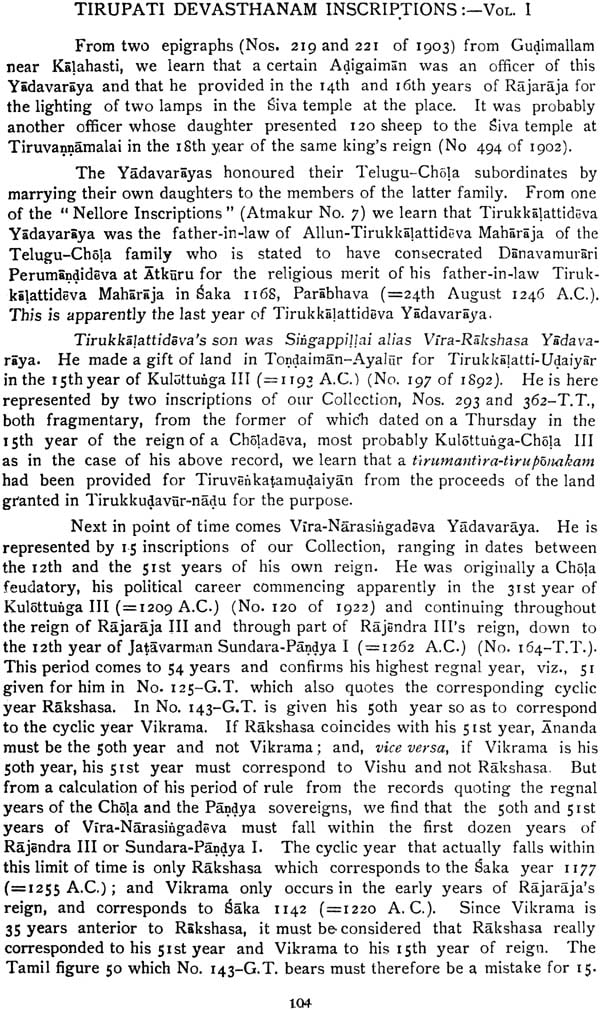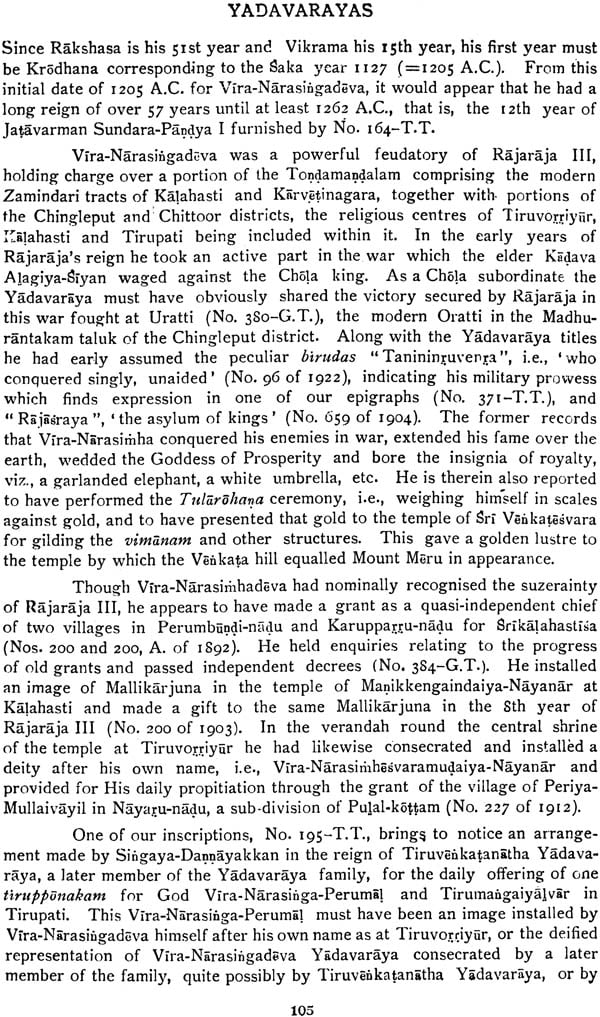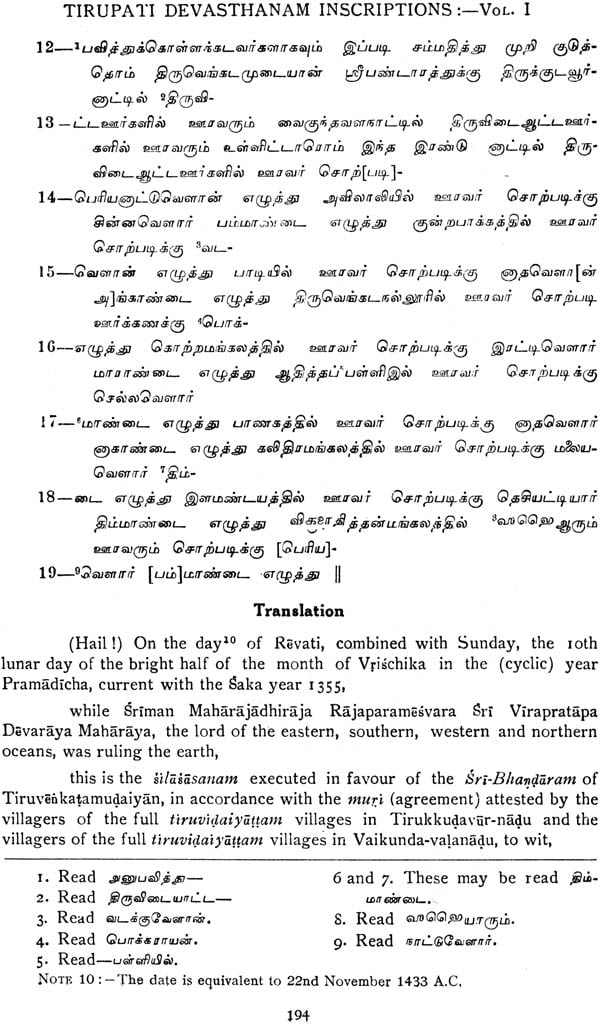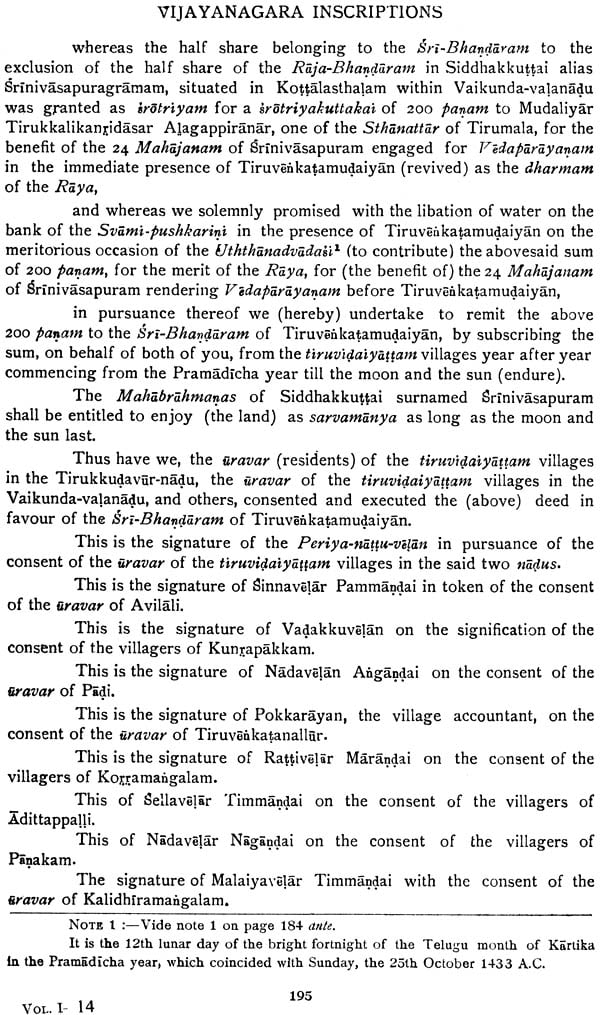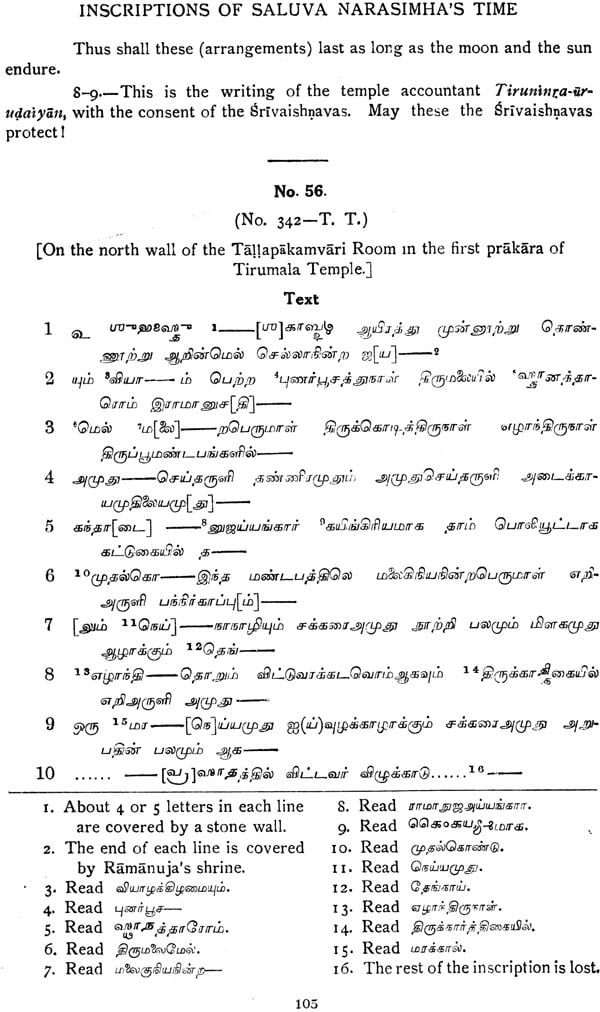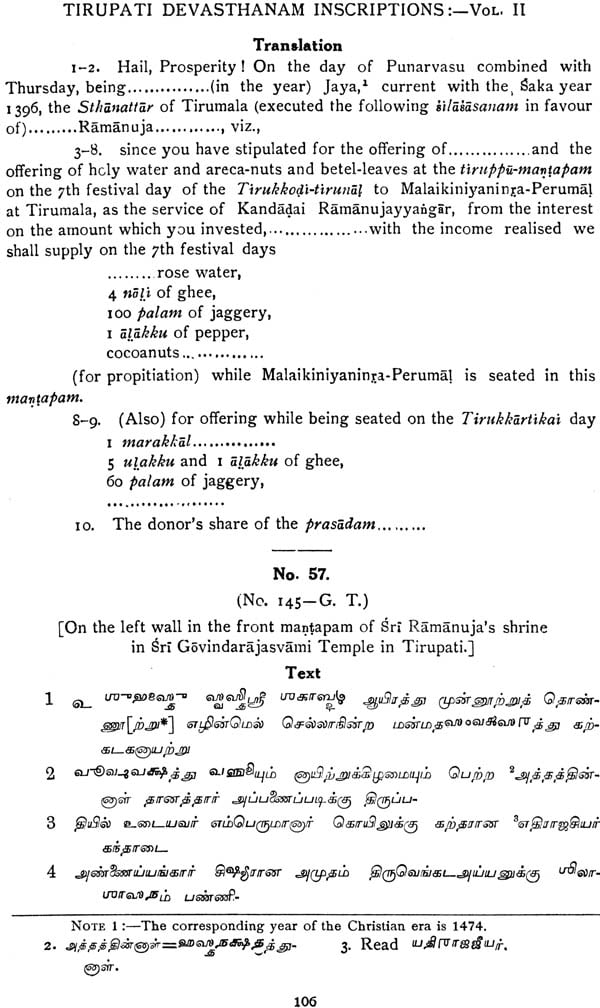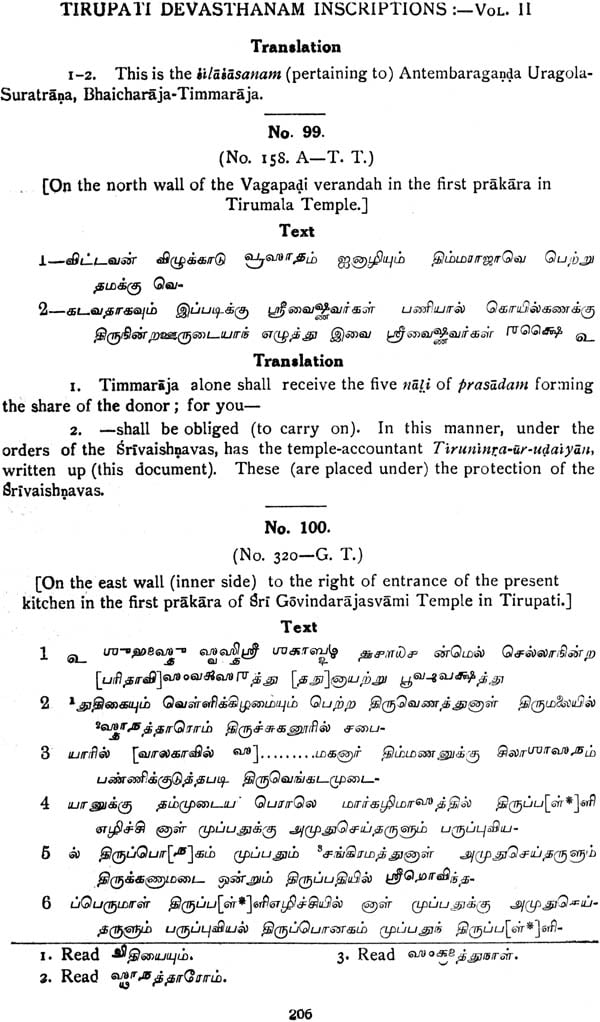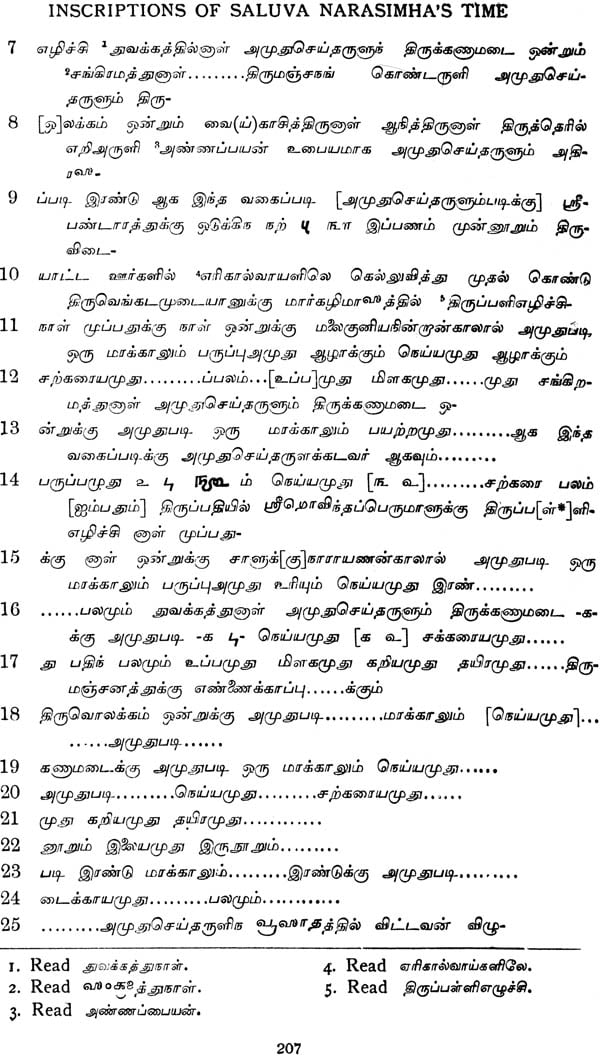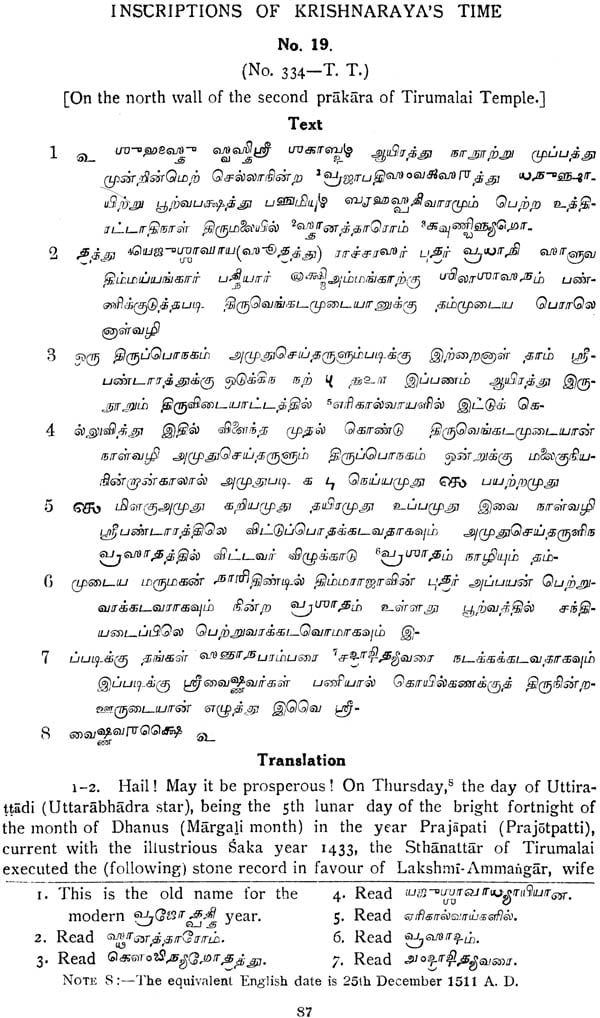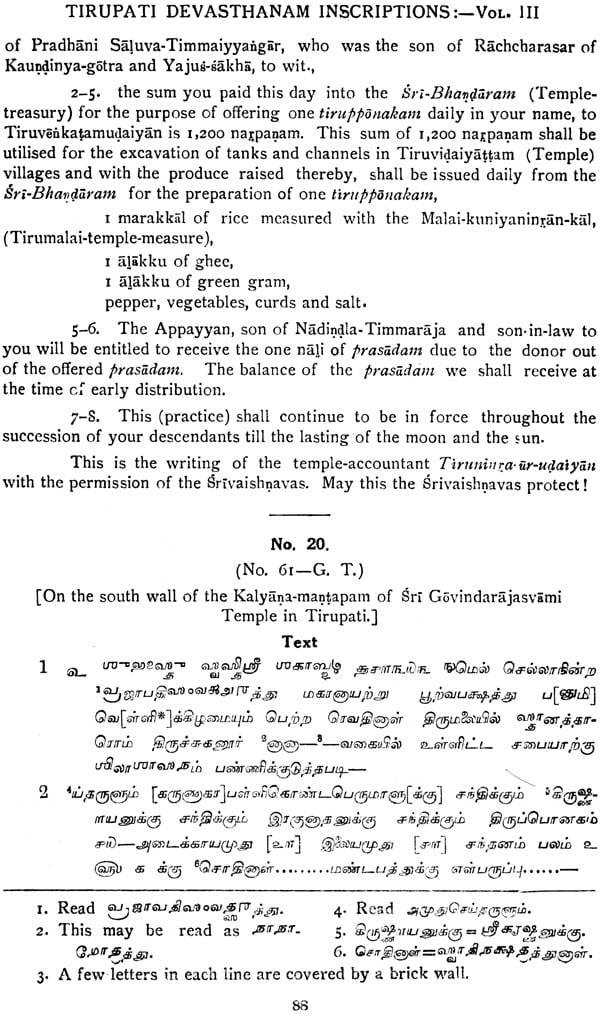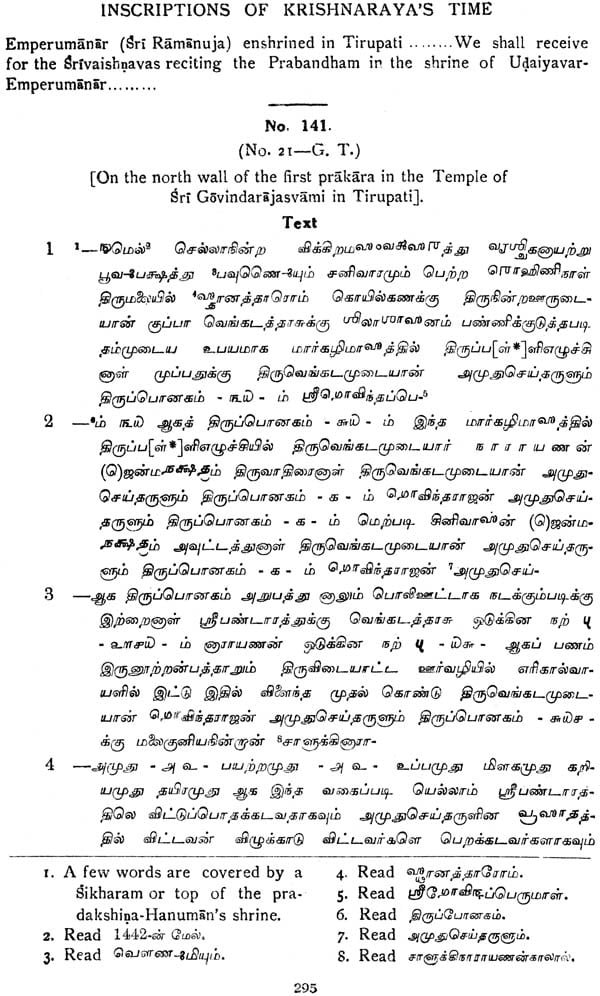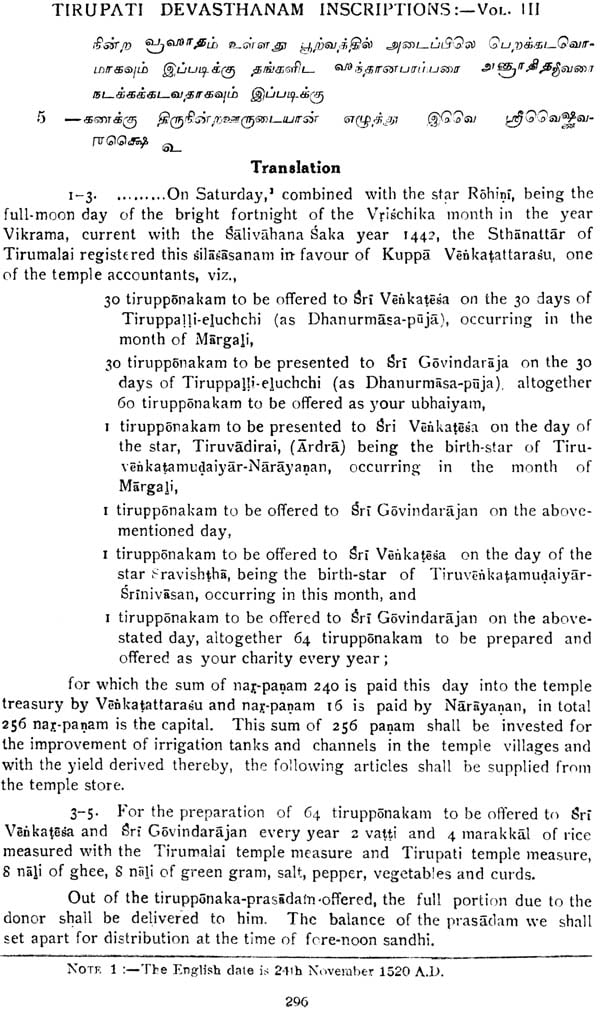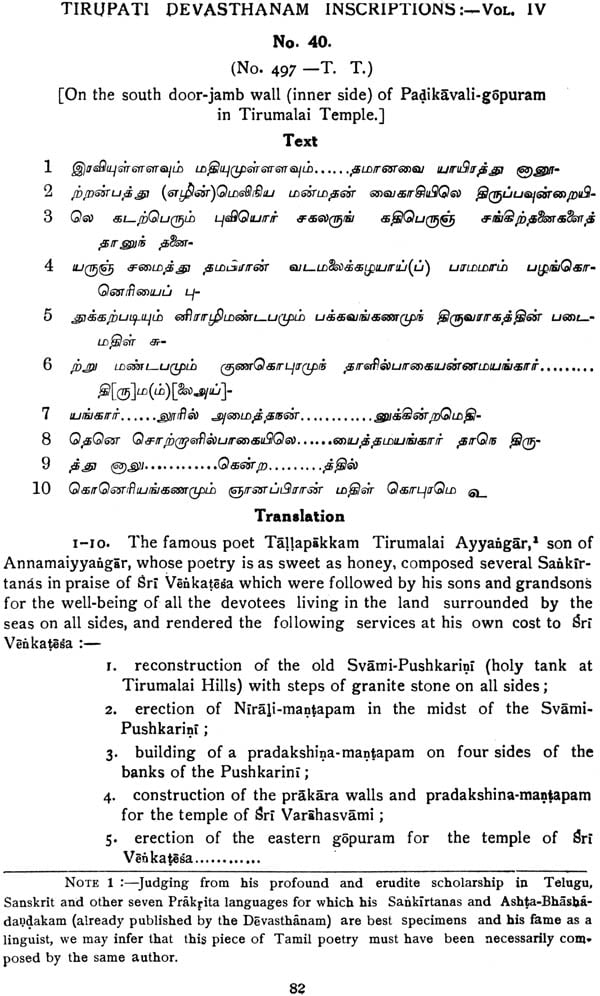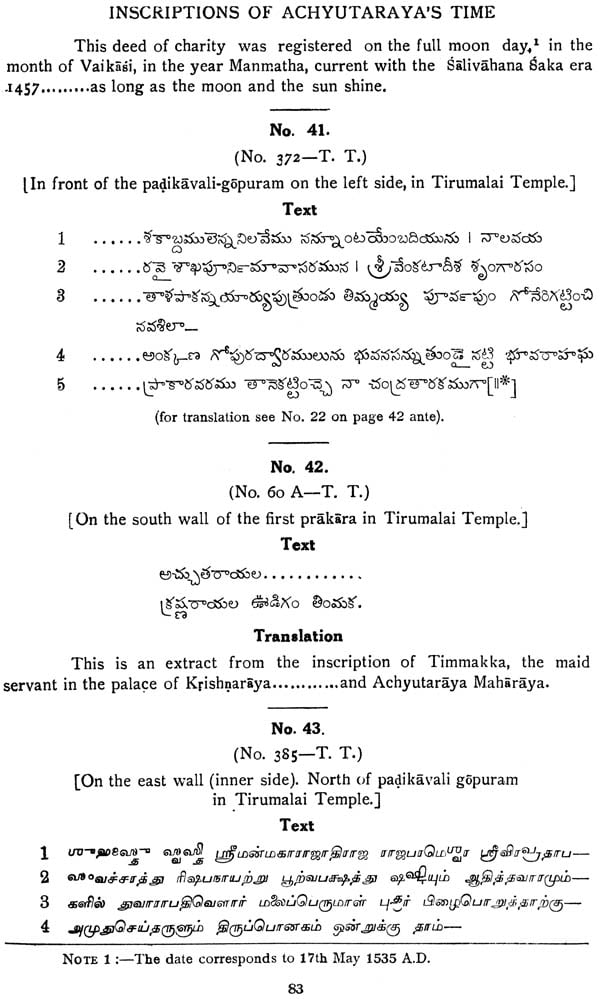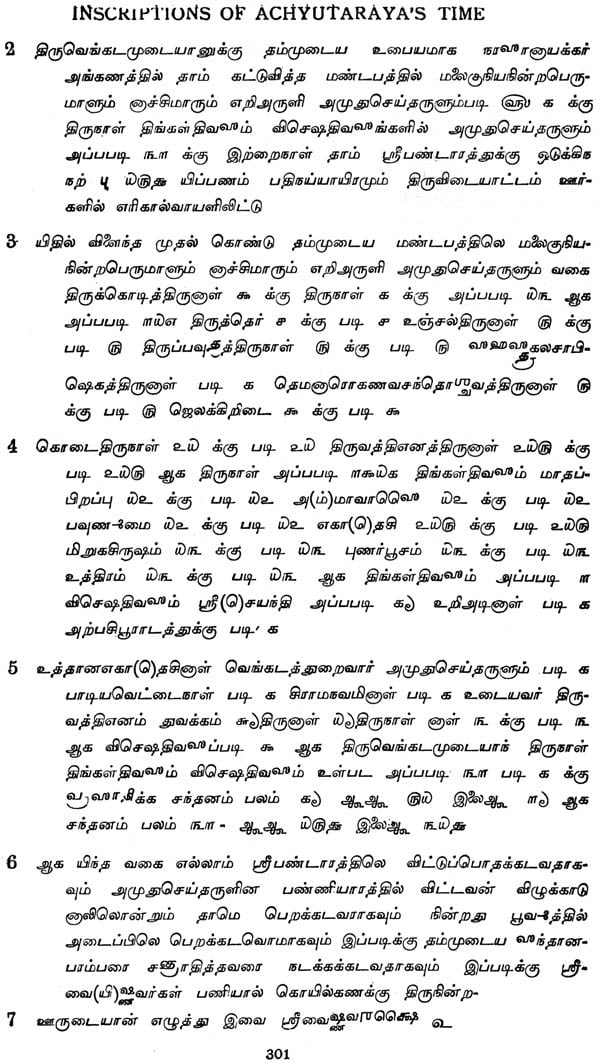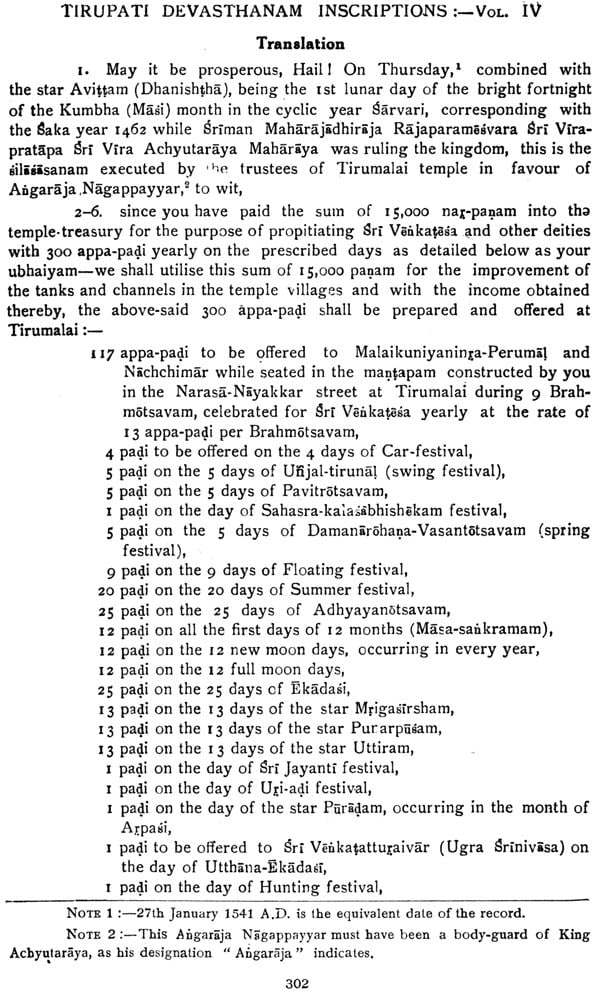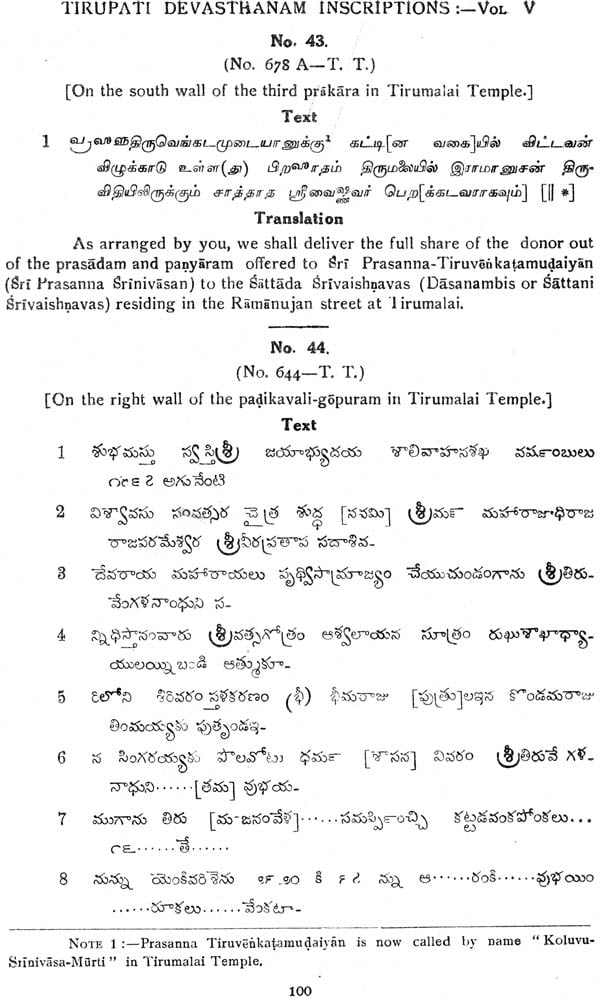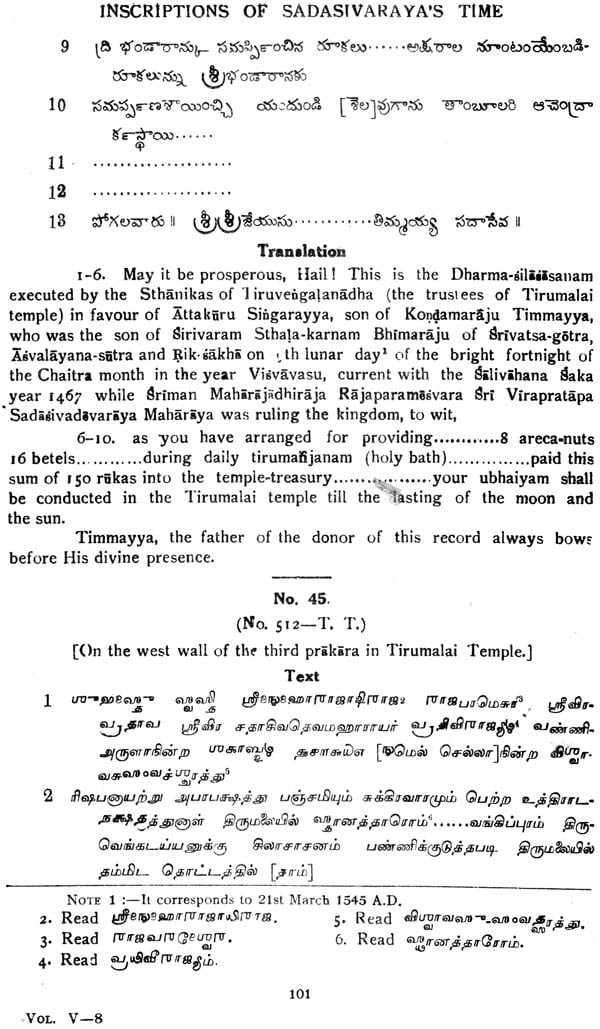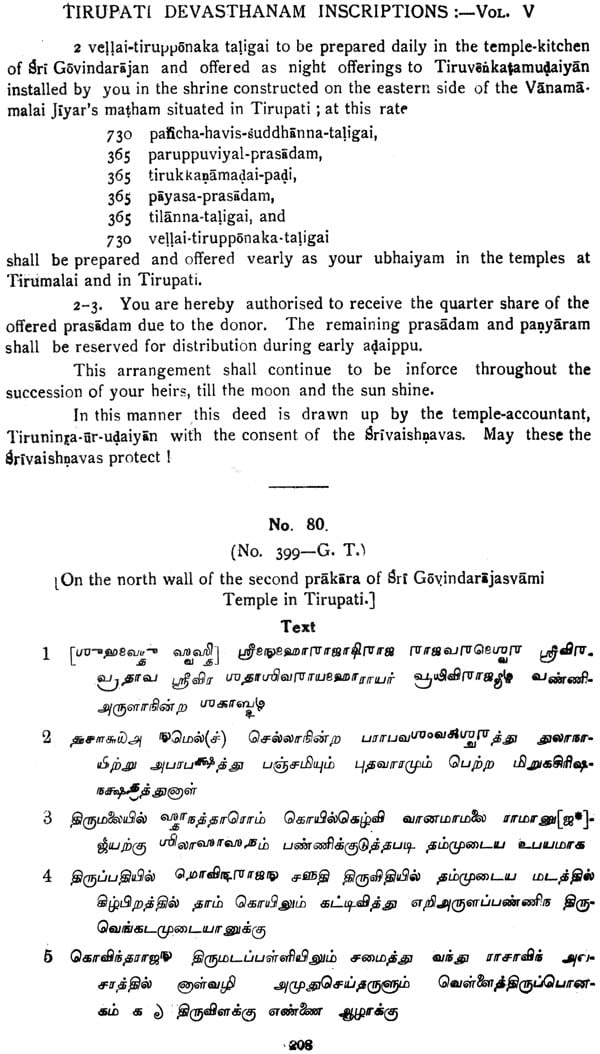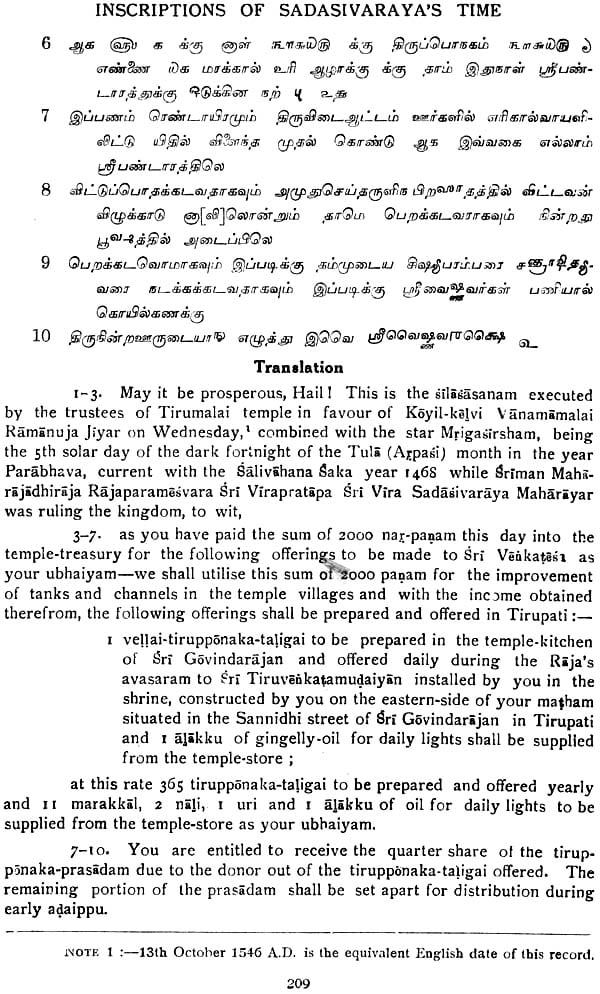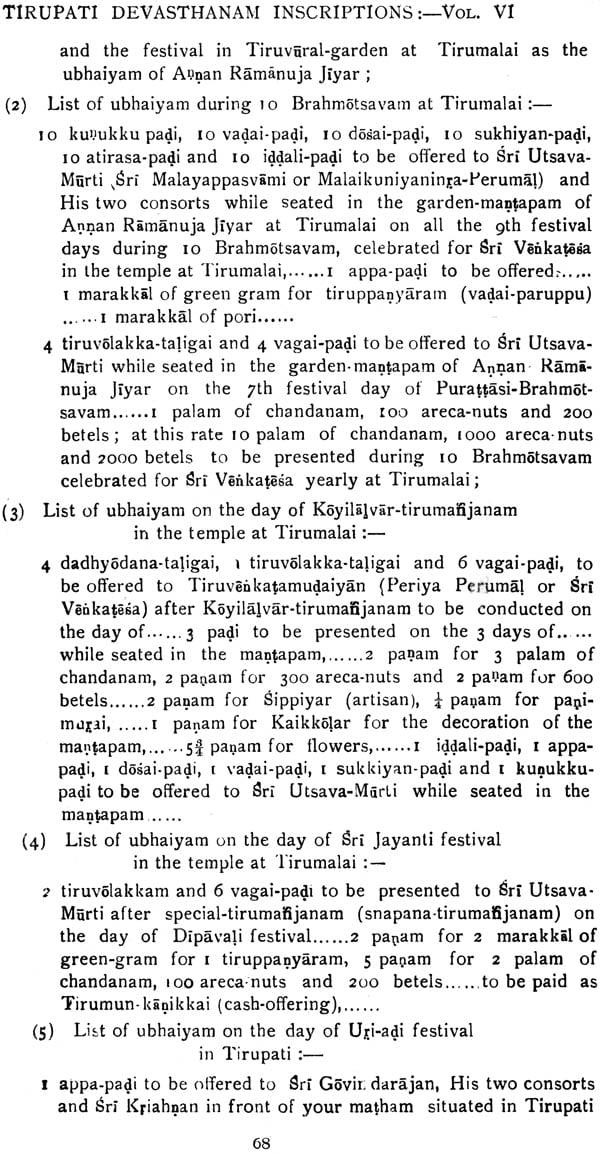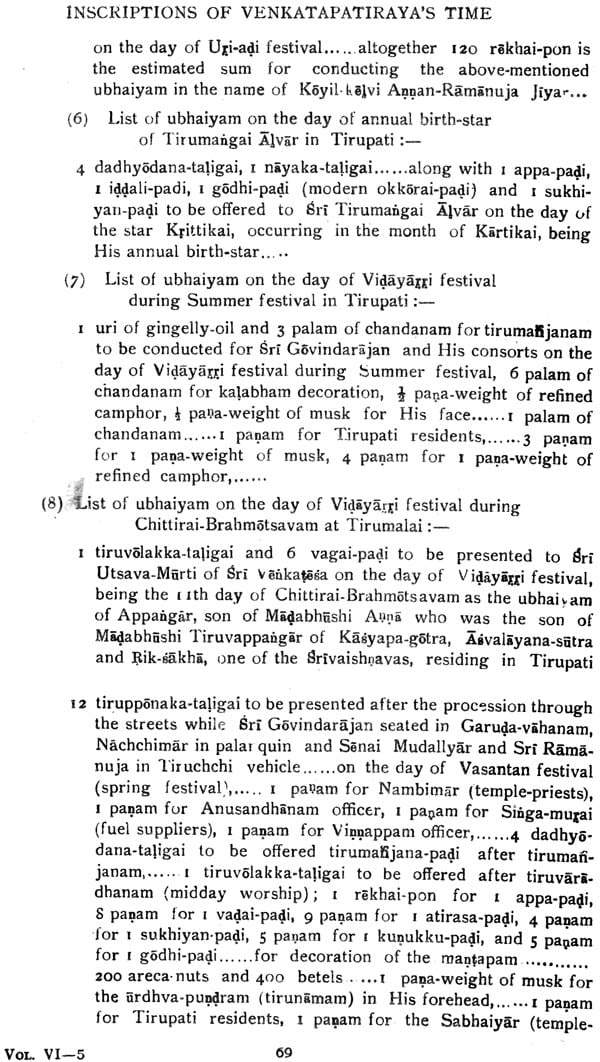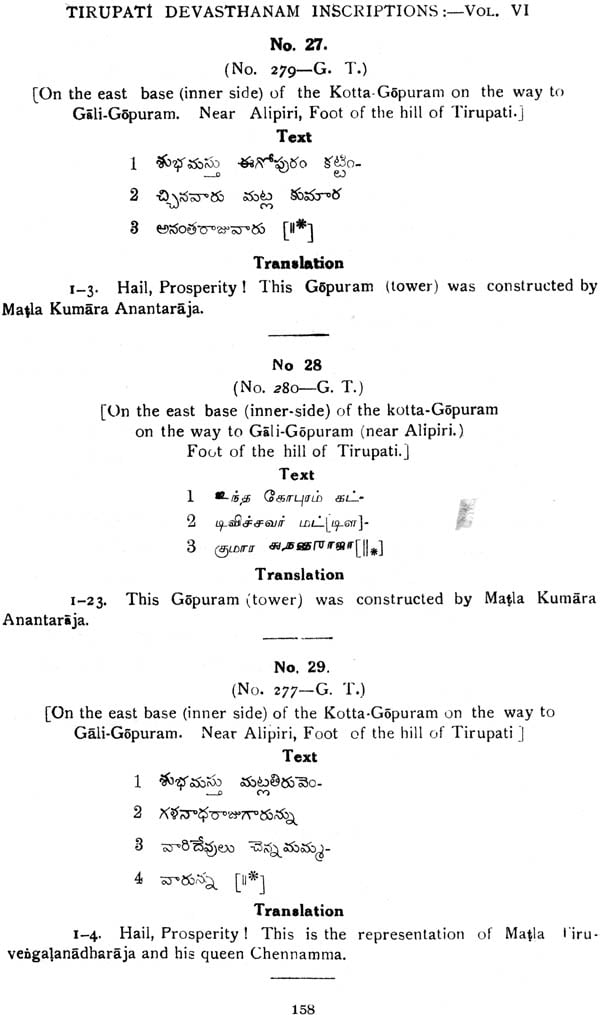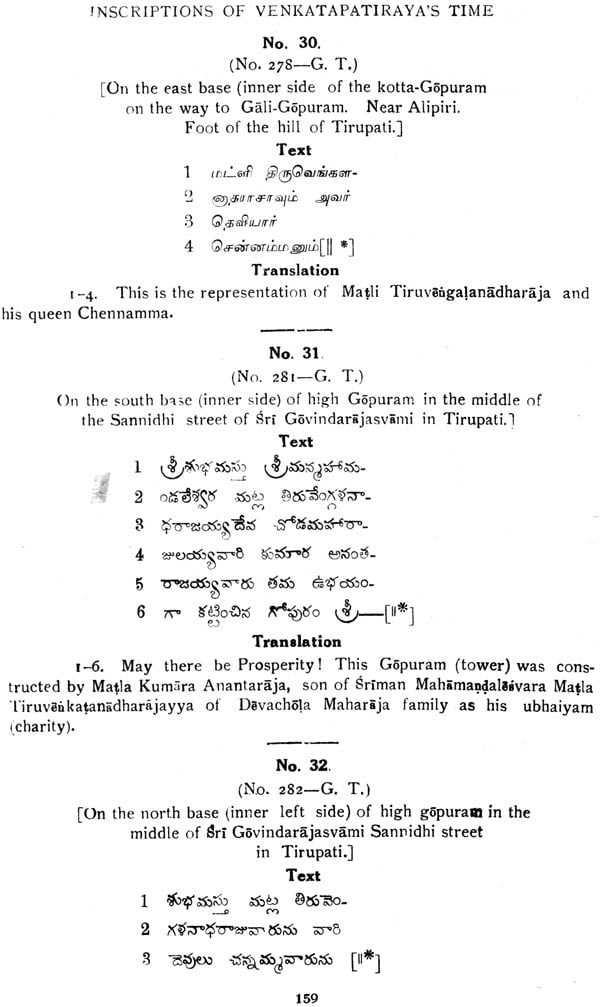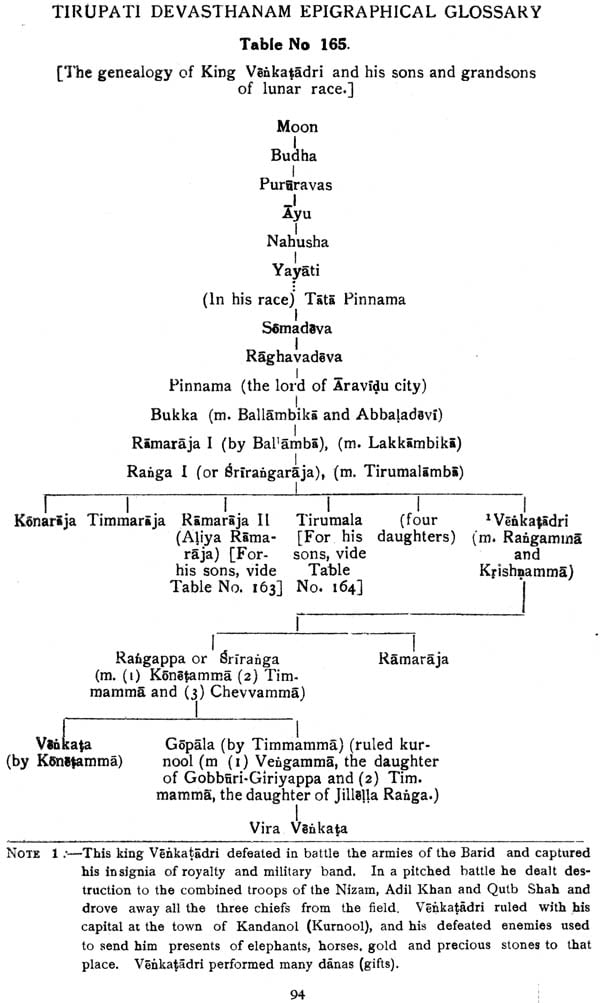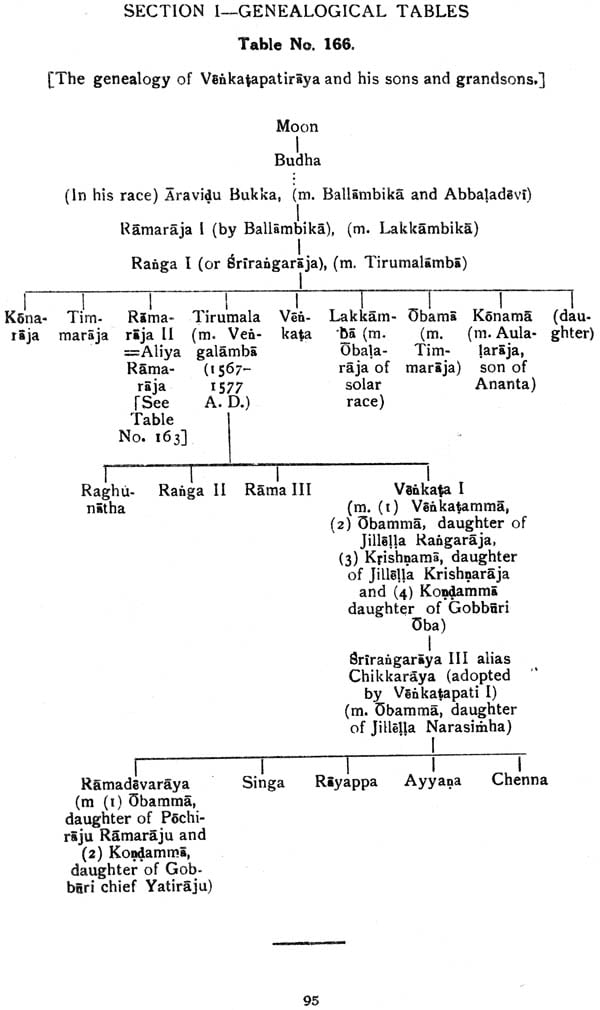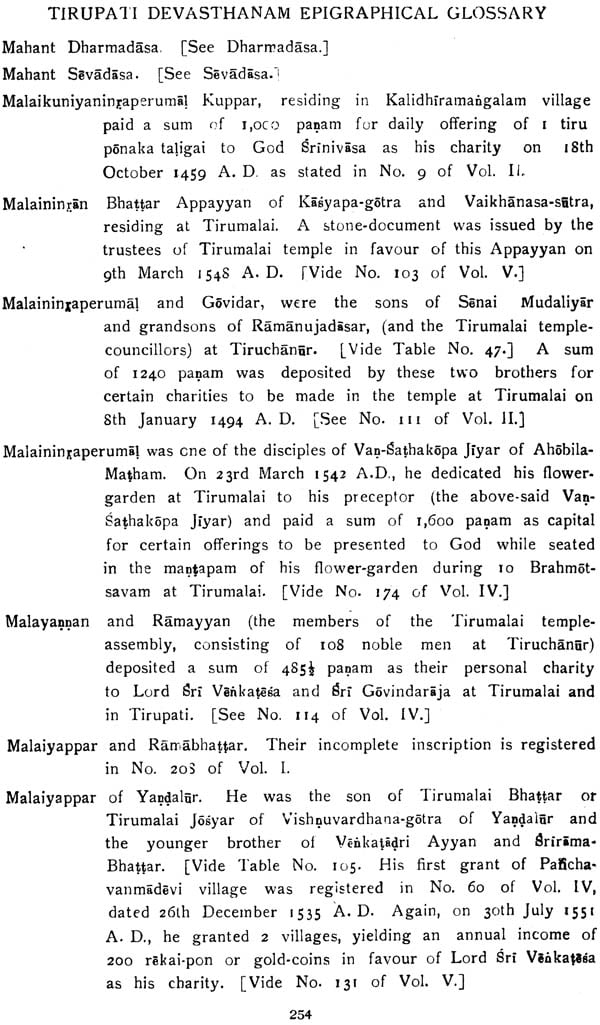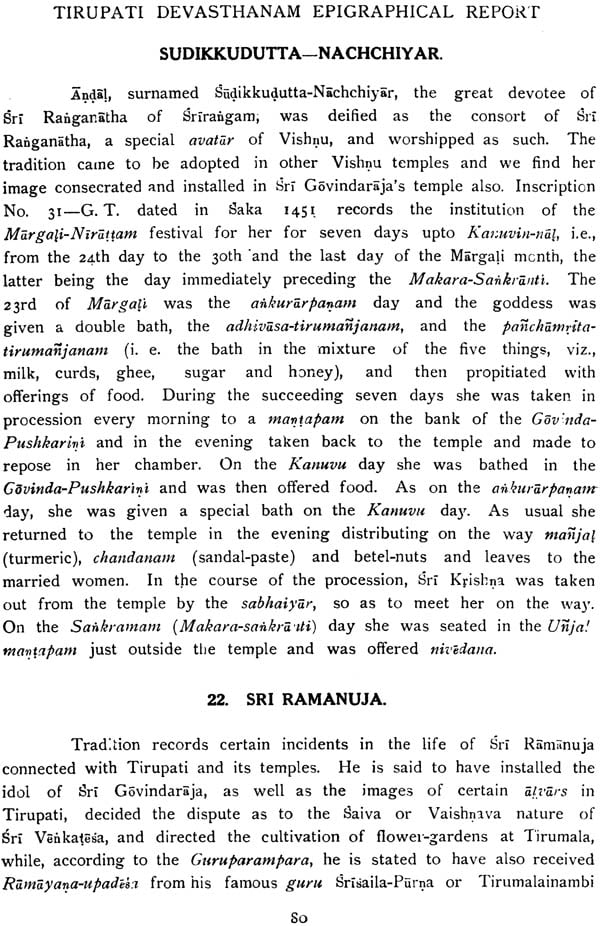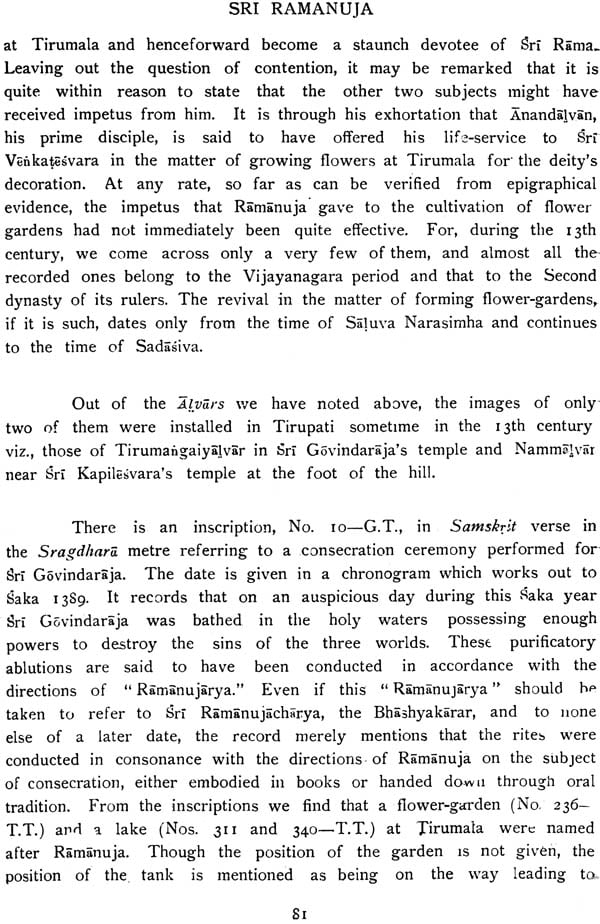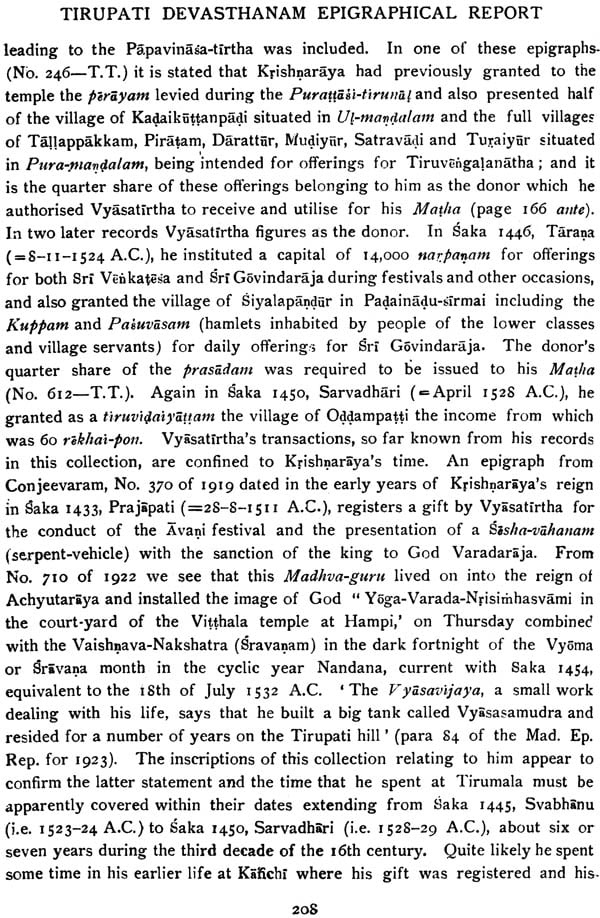
Tirumala Tirupati Devasthanams Inscriptions (Set of 8 Volumes) - An Old and Rare Book
Book Specification
| Item Code: | NAK993 |
| Author: | V.Vijayaraghav Acharya |
| Publisher: | Tirumala Tirupati Devasthanams, Tirupati |
| Language: | Tamil Text With English Translation |
| Edition: | 1998 |
| Pages: | 3394 (94 B/W Illustrations) |
| Cover: | Hardcover |
| Other Details | 11.0 inch x 9.0 inch |
| Weight | 9.40 kg |
Book Description
This set consists of the following 8 Books:
Early Inscriptions
Inscriptions of Saluva Narasimha,s Time (From 1445 A.D to 1504 A.D)
Inscriptions of Krishnaraya,s Time (From 1509 A.D to 1531 A.D)
Inscriptions of Achyutaraya,s Time (From 1530 A.D to 1542 A.D)
Inscriptions of Sadasivaraya,s Time (From 1541 A.D to 1574 A.D)
Inscriptions of Venkatapatriya's Time
Epigraphical Glossary on Tirumala Tirupati Devasthanams Inscriptions
Report on The Inscriptions of The Devasthanam Collection With Illustrations
Foreword
Inscriptions are one of the basic source material for the study of history. They throw a flood of light on the spiritual and temporal aspects of a society and provide valuable information about the social and economic life of the period. The deciphering and classification of inscriptions engraved on the temple walls at Tirumala and Tirupati acquires much significance in this context. When the Devasthanams took up the formidable task of classifying and transcribing these inscriptions way back in the 20's it opened up a new chapter in the historical research on Tirumala Tirupati temples. Sri Sadhu Subrahmanya Sastrywho was entrusted with deciphering and classifying them had done it with meticulous care.
In the 'Report' Sri Subrahmanya Sastry has given a general survey of the inscriptions during the Pallava, Chola, Pandya and Vijayanagar periods besides incorporating some of the inscriptions during the period of the Mahants. It may be interesting to note that while the early inscriptions are recorded in Tamil script, the bulk of the inscriptions belonging to the Vijayanagar period are in Telugu and Kannada.
The present reprint of the TTD Epigraphical series consisting of seven volumes, besides the Report will enable the readers to have a comprehensive knowledge about the sacred temples at Tirumala and Tirupati and their growth and development through centuries. We have great pleasure in bringing out the reprints of the Inscriptions which had been out of print for several years, for the benefit of the discerning public.
A "Preface" I take it, is an opportunity both for explanation and acknowledgement. The epigraphical publications of the Devasthanam are the fruition of the Proposal gracefully approved in 1921 by his Holiness sri Mahant Prayagadasji Varu, Vichsranakarta of the Tirumala, Tirupati & e. Devasthanams, at the instance of the then Diwan Peshkar of his, M.R.Ry., C. Doraswamiah Garu, B.A., B.L., (now Deputy Collector, Tanjore), and on the Suggestion proffered during his visit to Tirupati in company with Dr. F. W. Thomas of the India Office Library, to give my humble self an adequated epigraphical training and then carry on the work in the Devasthanam through me under his Holiness direct supervision. On being addressed in the matter by His Holiness direct supervision. On being addressed in the matter by his holiness, The Government of Madras were Pleased to accord their sanction in G.O. No. 610 (Finance dated the 14th June 1921, for my training in the office of the Assistant Archaeological Superintendent for Epigraphy, Southern Circle Madras. With a seven months' training I returned to Tirupati in March 1922 and commenced copying the inscriptions from the walls of the Temples in Tirupati and Tiruchanur, and on securing about 650 I compiled the first part of the report relating to the Religious routine in the temples. But the historical material furnished in these records as well as in those of the later collection prompted me to attempt an historical account of the South Indian dynasties represented in them and I set myself to the task. The dynastic rulers apart, the royal subordinates and religious preceptors that flourished in the different periods needed to be clearly identified and this involved a research extending over some time. Again, the epigraphs of Krishnadevaraya, registering, as they did, not merely the donations of himself and his two queens but also his military achievements in his wars against the Gajapati King Prataparudra, Necessitated a closer study of his military career in the light of his records found elsewhere correlated to contemporary literary evidence; and the inevitable discussion of the several campaigns and events of his ars as well as the dates there of in relation to his frequent visits to the shrine of Sri Venkatesvara had tended to transform his account into a monograph on his Gajapati Wars. Similar mention may be made of the account of the Tallapakam poets. And this disquisitive Report I Herewith present to the reading public, with illustrations of views of Temples, Mantapama, gupurams, vahanams, water-falls, etc.
To have stimulated my propensity for historical research and helped me to carry on the work in this field for these eight years I offer my hearty thanks primarily to His Holiness Sri Mahant Prayagadasji Varu, Vicharanakarta of the Devasthanams, and to the then Diwan –Peshkar M. R. Ry., C. Doraswamiha Garu, B.A., B.L., as well as to the Government of Madras for their permission for my epigraphical training to put me in the line. I hereby acknowledge my obligations to the late Rao Bahadur H. Krishna Sastriar and to the late Mr. G Venkoba Rao, formerly Assistant Archaeological Superintendent and to Messrs C. R. Krishnamacharlu Garu, B.A (now Superintendent for Epigraphy, Facilities ), G. Srinivasa Rao Avl, B.A., V.Venkatasubba lyar Avl, B.A, and other members on the staff of the Epigraphical office, madras for the facilities they courteously afforded me for my observation and exploration in the field. For the active co-operations and assistance rendered to me in the course of my working at the inscriptions in the devasthanam, my thanks are particularly due to my Pandit M. R. Ry., V. Vijayaraghavachariar Avl., and M. R. Ry., R. Krishna Rao Avl, B.A., L.T as also to M. R. Ry., M. Ramakrishna Kavi Garu, M.A, who looked through the proofs of the latter part of the Report during its printing. I cannot adequately express my thanks to M.R. Ry. K. A. Nilakanta Sastri Avl, M.A. Professor of Indian History and Archaeology, Madras University, for the ready courtesy with which he contributed the Introduction to this Report at my Request. I should be failing in my duty if I do not acknowledge my obligations to Messrs P. Chaenchuramiah of the Devasthanam Engineering Department for his preparation under my direction of the Map of South India showing the conquests of Krishnadevaraya and K. B. Ranganatha Rao, my clerk, for the compilation of the Index under my instructions.
For having hitherto enabled me to fulfil my purpose partially, and for granting me strength and opportunity to fulfil that purpose fully in the near Future, I offer my prayers to the benign Sri Venkatesvara under whose protective care the epigraphical work has progressed so far.
As to the plan of the publication of the 1150 inscriptions altogether secured from the Temples here, it is intended to issue them in six volumes in chronological order. The first volume comprises 236 epigraphs of the Pallava, Chola, Pandya and the First Vijayanagara Periods which are provided with an English Translation and brief Historical Introductions for the different dynasties. The remaining volumes will similarly be issued with Translation and Introduction and will represent individually the periods of Saluva Narasimha with 169 inscriptions, Krishnaraya with 229, Achyutaraya with 251, Sadasivaraya with 147 and the Kings of the Aravidu Dynasty with 135 inscriptions.
The Copper-Plates of the Tallapakam Poets are two Kinds Viz., minor poems treating of Prosody, minor poems treating of prosody, grammar, ethical rules, & c., and the Sankirtanas Viz., srinara – Sankirtanas, Adhyatma – Sankirtanas and Vairagya Sankirtanas. The minor poems are now in Print under the editorship of M.R. Ry., M. Ramakrishna Kavi Garu, M.A., who will also issue the Sankirtanas after the Publication of these minor poems in a small volume.
It is with pleasure that I comply with the wish expressed by Mr. Sadhu Subrahmanya Sastry that I should write a few words by way of Introduction to his Epigraphical Report on the Temples of the Tirupati Devasthanam. This celebrated shrine which has for centuries attracted enormous numbers of pilgrims from all parts of India has, at least since the days of the Vijayanagar rulers, continuously enjoyed a magnificent income from the votive offerings of its devotees. Of all the sacred spots (Tirupatis) of Southern India, that on the Hill of Vengadam came very early to be recognised as Tirupati par excellence. Still the temple of Tirupati is not, either in its size or in its architecture and sculpture, comparable to the temples of Kanchipuram, Madura and many other places. The present structure is comparatiyely modern and dates from the 13th century A. D. and in recent times the growth of the town round the temple would appear to have encroached on its precincts. The earliest mention of the hill on which Tirupati stands in found in the Tamil literature of the Sangam age. The Northern Vengadam (Vada Vengadam) was at that time on the border land between the Tamil country and that of the vadugar. A verse (No 211) in the Ahananuru for instance speaks of the people in the land beyond the cool groves of Vengadam where the language changes form Tamil to Telugu or rather Vadugu as the Tamils then called it. For the first, the hill is associated with Vishnu in the phrase Nediyon-kunram of Silppadikaram and in the beautiful lines in the Kadunkankadai which portray the hill is associated with Vishnu on the top of the high hill called Vengadam. Tirupati holds an honoured place in the minds of the Vaishnava Alvars. One of them, Kulasekhara, prays that he might be born again as a bird, a bush, a stream or something on the golden hill of vengadam. Another, peyalvar, describes how the kindly god of Tirumalai unites in himself the twin forms of Siva and Vishnu. The opinion often expressed that this temple was originally dedicated to siva and was subsequently converted by Ramanuja into a Vaishnava shrine is based only on a misinterpretation of one of the many legends in Vaishnava hagiology that have centred round the name of the great reformer.
This temple like others bears on its walls several inscriptions of considerable interest not only to the scholars but to all persons who desire to know something of the ancient and time-honoured institutions of our country. These inscriptions together with others from the neighbouring temples in Lower Tirupati and Tiruchanur, making a told of well over a thousand, furnish a continuous and authentic record of the transactions of the temple and its neighbourhood for the last seven or eight centuries. We have full information on the buildings and endowments and the numerous visits to the temple of the Vijayanagar rulers, especially of the illustrious Krishna Deva Raya. Among the great rulers of South India, Raja Raja Chola is the earliest who is known, from a late and faulty copy of an inscription of the sixteenth year of his reign, to have been directly connected with the main shrine of Tirumalai. We may infer from fragments of earlier records found in the neighbourhood, like that of Dantivarman in tiruchanur, that many of the more ancient inscriptions have disappeared beyond recovery as a result of restorations undertaken in the 13th century A. D. and later. Authentic information on the original construction of the flights of steps leading up the hill of Tirupati and on other matters is very limited as indeed is our knowledge of the early history of the temple itself.
The relative lateness of the bulk of the inscriptions treated of here does not in any way detract from the value of the undertaking. It is a great thing to have renovation. The Devasthanam has earned the gratitude of the public by their employment for some years of a competent epigraphist like Mr. Sadhu Subrahmanya Sastry in the pursuit of this important and useful task. A work like the present Report necessarily labours under some disadvantages. It can neither offer a finished history nor simply present the original materials as it is and leave the reader to study it for himself. It has to analyse the records of some extent under convenient heads, provide summaries of them and hazard identifications and explanations as occasion suggests. Repetition of the same facts in different connections is often inevitable. Mr. Ssubrahmanya Sastry has done his best to overcome the intrinsic difficult of his task and produced a Report which is full, well-documented and eminently readable. In Part I he gives a succinct account routine of services in the main temples, its occasional festivals, its Vahanams, its flower – gardens and feeding house, before he discusses the lesser shrines and the Jiyar – math. He has, with great skill and patience, fitted into this general sketch many little details drawn from the inscriptions. Part II is taken up by a historical account of the South Indian dynasties represented in the epigraphical collection that forms the subject of the Report. Though the treatment of the Pallavas, the Cholas and the Pandyas may strike the reader as being somewhat more elaborate than the few inscriptions of their time may warrant, he will on the whole be grateful to Mr. Subrahmanya Sastry for not having adopted a too restricted view of the scope of his report. The amount of fresh information Mr. Sastry has culled from Telugu literature on the kinds of Vijayanagar and their feudatories, and on the religious teachers of the time will be read with considerable interest. In this section of the work, and this is the bulk of the second part of the Report, Mr. Subrahmanya Sastry has made a substantial contribution to the general knowledge of Vijayanagar history.
Before concluding, I wish to add that this Report, great as is its value, should be followed by texts of the inscriptions with undue dely. However full and accurate an epigraphical report may be made by its author and there is n question that Mr. Subrahmanya Sastry's Report is among the best of its kind, it is no detraction from the merit of such a report to say that it con not be a substitute for the texts on Which it is based. It may also be suggested that a large and representative selection from the thousands of Sankirtanas on about 3000 copper plates preserved in the temple, and these on would constitute an interesting supplement to the texts of the stone inscriptions.
